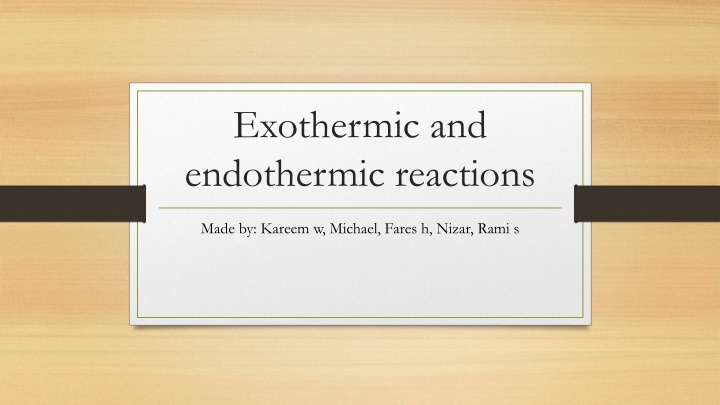
Exothermic and Endothermic Reactions: Alkali Metals and Water
Discover the reactions of alkali metals Lithium, Sodium, Potassium, Rubidium, and other substances like Ammonium Nitrate, Boron Nitrate, and Zinc Oxide with water, illustrating both exothermic and endothermic processes. Witness the energetic interactions and transformations these elements undergo in the presence of water, from fiery reactions to absorbing energy and turning cold. Explore the fascinating world of chemical reactions creating different outcomes.
Download Presentation

Please find below an Image/Link to download the presentation.
The content on the website is provided AS IS for your information and personal use only. It may not be sold, licensed, or shared on other websites without obtaining consent from the author. If you encounter any issues during the download, it is possible that the publisher has removed the file from their server.
You are allowed to download the files provided on this website for personal or commercial use, subject to the condition that they are used lawfully. All files are the property of their respective owners.
The content on the website is provided AS IS for your information and personal use only. It may not be sold, licensed, or shared on other websites without obtaining consent from the author.
E N D
Presentation Transcript
Exothermic and endothermic reactions Made by: Kareem w, Michael, Fares h, Nizar, Rami s
Exothermic substances in a reaction with water Lithium reaction with water Lithium is the first of the alkali metals and reacts vigorously with water. It commonly produces a red flame. The substance after the reaction is hydrogen gas and lithium hydroxide. This lithium was obtaine Show more Lithium is the first of the alkali metals and reacts vigorously with water. It commonly produces a red flame.
sodium Soduim reaction with water When sodium is added to water, the sodium melts to form a ball that moves around on the surface. It fizzes rapidly before it disappears. When potassium is added to water, the metal melts and floats. It moves around very quickly on the surface of the water. The metal self-ignites, which also ignites the hydrogen gas.
potassium When potassium is added to water,the metal melts and floats. It moves around very quickly on the surface of the water. The metal self-ignites, which also ignites the hydrogen gas. This results in sparks and a lilac flame. There is sometimes a small explosion at the end of the reaction.
rubidium Rubidium is denser than water and so sinks. It reacts violently and immediately, with everything spitting out of the container again.Rubidium hydroxide solution and hydrogen are formed. Caesium explodes on contact with water, quite possibly shattering the container. Caesium hydroxide and hydrogen are formed
Endothermic substances with water reactions Amonuiom nitrate with water Ammonium nitrate consists of ionic bonds packed tightly together. When it comes into contact with water, the polar water molecules interfere with those ions and eventually make them disperse. It takes energy to do this, which is absorbed from the surroundings and makes the solution cold.
Boron nitrate Boron nitride water-based coatings are available in one and five gallon containers, and in several grades. Water dilution is recommended to enhance application for GPC due to higher solids content. Other grades may be diluted as needed. FPD can be easily reconstituted in a container with the required amount of water using a standard paint mixer.
Zinc oxide Zinc oxide reacts with hydrochloric acid to form zinc chloride and water. Zinc oxide is insoluble in water. State and explain whether zinc oxide is a base, an alkali, or both. A neutralisation reaction is a reaction between an acid and a base. Remember:
Magnesuim chloride When exposed to steam, magnesium changes from magnesium to magnesium oxide and hydrogen. When exposed to cold water, the reaction is a bit different. The reaction does not stop because the magnesium hydroxide gets insoluble in water. What is magnesium chloride anhydrous used for?
